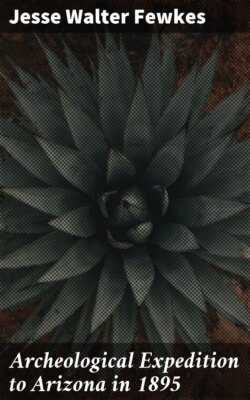Читать книгу Archeological Expedition to Arizona in 1895 - Jesse Walter Fewkes - Страница 12
На сайте Литреса книга снята с продажи.
Cliff Houses of the Red-Rocks
ОглавлениеTable of Contents
After the road from old Camp Verde to Flagstaff passes a deserted cabin at Beaver Head, it winds up a steep hill of lava or malpais to the top of the Mogollones. If, instead of ascending this hill, one turns to the left, taking an obscure road across the river bed, which is full of rough lava blocks, and in June, when I traveled its course, was without water, he soon finds himself penetrating a rugged country with bright-red cliffs on his right (plate xcviii). Continuing through great parks and plains he finally descends to the well-wooded valley of Oak creek, an affluent of Rio Verde. Here he finds evidences of aboriginal occupancy on all sides—ruins of buildings, fortified hilltops, pictographs, and irrigating ditches—testifying that there was at one time a considerable population in this valley. The fields of the ancient inhabitants have now given place to many excellent ranches, one of the most flourishing of which is not far from a lofty butte of red rock called the Court-house, which from its great size is a conspicuous object for miles around. In many of these canyons there are evidences of a former population, but the country is as yet almost unexplored; there are many difficult places to pass, yet once near the base of the rocks a way can be picked from the mouth of one canyon to another. It does not take long to discover that this now uninhabited region contains, like that along the Verde and its tributaries, many ancient dwellings, for there is scarcely a single canyon leading into these red cliffs in which evidences of former human habitations are not found in the form of ruins. There is little doubt that these unfrequented canyons have many and extensive cliff houses, the existence of which has thus far escaped the explorer. The sandstone of which they are composed is much eroded into caves with overhanging roofs, forming admirable sites for cliff houses as distinguished from cavate dwellings like those we have described. They are the only described ruins of a type hitherto thought to be unrepresented in the valley of the Verde.[23]
In our excursion into the Red-rock country we were obliged to make our own wagon road, as no vehicle had ever penetrated the rugged canyons visited by us. It was necessary to carry our drinking water with us from Oak creek, which fact impeded our progress and limited the time available in our reconnoissance. There was, however, in the pool near the ruins of Honanki enough water for our horses, and at the time we were there a limited amount of grass for fodder was found. I was told that later in the season both forage and water are abundant, so that these prime necessities being met, there is no reason why successful archeological investigations may not be successfully conducted in this part of the Verde region.
The limited population of this portion of the country rendered it difficult to get laborers at the time I made my reconnoissance, so that it would be advisable for one who expects to excavate the ruins in this region to take with him workmen from the settled portions of the valley.
